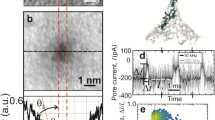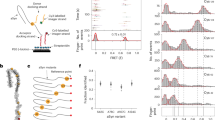Abstract
The human proteome has millions of protein variants due to alternative RNA splicing and post-translational modifications, and variants that are related to diseases are frequently present in minute concentrations. For DNA and RNA, low concentrations can be amplified using the polymerase chain reaction, but there is no such reaction for proteins. Therefore, the development of single-molecule protein sequencing is a critical step in the search for protein biomarkers. Here, we show that single amino acids can be identified by trapping the molecules between two electrodes that are coated with a layer of recognition molecules, then measuring the electron tunnelling current across the junction. A given molecule can bind in more than one way in the junction, and we therefore use a machine-learning algorithm to distinguish between the sets of electronic ‘fingerprints’ associated with each binding motif. With this recognition tunnelling technique, we are able to identify D and L enantiomers, a methylated amino acid, isobaric isomers and short peptides. The results suggest that direct electronic sequencing of single proteins could be possible by sequentially measuring the products of processive exopeptidase digestion, or by using a molecular motor to pull proteins through a tunnel junction integrated with a nanopore.
This is a preview of subscription content, access via your institution
Access options
Subscribe to this journal
Receive 12 print issues and online access
$259.00 per year
only $21.58 per issue
Buy this article
- Purchase on Springer Link
- Instant access to full article PDF
Prices may be subject to local taxes which are calculated during checkout





Similar content being viewed by others
References
Uhlen, M. & Ponten, F. Antibody-based proteomics for human tissue profiling. Mol. Cell. Proteom. 4, 384–393 (2005).
National Research Council (US) Committee on Intellectual Property Rights in Genomic and Protein Research and Innovation. Reaping the Benefits of Genomic and Proteomic Research: Intellectual Property Rights, Innovation, and Public Health (National Academies Press, 2006).
Archakov, A. I., Ivanov, Y. D., Lisitsa, A. V. & Zgoda, V. G. AFM fishing nanotechnology is the way to reverse the Avogadro number in proteomics. Proteomics 7, 4–9 (2007).
Huang, S. et al. Identifying single bases in a DNA oligomer with electron tunneling. Nature Nanotech. 5, 868–873 (2010).
Chang, S. et al. Electronic signature of all four DNA nucleosides in a tunneling gap. Nano Lett. 10, 1070–1075 (2010).
Huang, S. et al. Recognition tunneling measurement of the conductance of DNA bases embedded in self-assembled monolayers. J. Phys. Chem. C 114, 20443–22044 (2010).
Lindsay, S. M. et al. Recognition tunneling. Nanotechnology 21, 262001 (2010).
Friddle, R. W., Noy, A. & De Yoreoa, J. J. Interpreting the widespread nonlinear force spectra of intermolecular bonds. Proc. Natl Acad. Sci. USA 109, 13573–13578 (2012).
Chang, S. et al. Chemical recognition and binding kinetics in a functionalized tunnel junction. Nanotechnology 23, 235101 (2012).
Chang, C. C. & Lin, C. J. LIBSVM: a library for support vector machines. ACM Trans. Intell. Syst. Technol. 2, 27–52 (2011).
Chang, S. et al. Palladium electrodes for molecular tunnel junctions. Nanotechnology 23, 425202 (2012).
tuchband, M., He, J., Huang, S. & Lindsay, S. M. Insulated gold scanning tunneling microscopy probes for recognition tunneling in an aqueous environment. Rev. Sci. Instrum. 83, 015102 (2012).
Liang, F., Li, S., Lindsay, S. M. & Zhang, P. Synthesis, physicochemical properties, and hydrogen bonding of 4(5)-substituted-1H-imidazole-2-carboxamide, a potential universal reader for DNA sequencing by recognition tunneling. Chem. Eur. J. 18, 5998–6007 (2012).
Daniel, J. R. M., Friess, S. D., Rajagopalan, S., Wendt, S. & Zenobi, R. Quantitative determination of noncovalent binding interactions using soft ionization mass spectrometry. Int. J. Mass Spectrom. 216, 1–27 (2002).
Nesatyy, V. J. Mass spectrometry evaluation of the solution and gas-phase binding properties of noncovalent protein complexes. Int. J. Mass Spectrom. 221, 147–161 (2002).
Sreekumar, A. et al. Metabolomic profiles delineate potential role for sarcosine in prostate cancer progression. Nature 457, 910–914 (2009).
Fuhrmann, A. et al. Long lifetime of hydrogen-bonded DNA basepairs by force spectroscopy. Biophys. J. 102, 2381–2390 (2012).
tsutsui, M., Taniguchi, M., Yokota, K. & Kawai, T. Identification of single nucleotide via tunnelling current. Nature Nanotech. 5, 286–290 (2010).
Zwolak, M. & Di Ventra, M. Electronic signature of DNA nucleotides via transverse transport. Nano Lett. 5, 421–424 (2005).
Cover, T. M. Geometrical and statistical properties of systems of linear inequalities with applications in pattern recognition. IEEE Trans. Electron. Comput. EC-14, 326–334 (1965).
Jethava, V., Martinsson, A., Bhattacharyya, C. & Dubhashi, D. The Lovász θ function, SVMs and finding large dense subgraphs. Neural Inf. Proc. Syst. 1169–1177 (2012).
Kühnle, A., Linderoth, T. R., Hammer, B. & Besenbacher, F. Chiral recognition in dimerization of adsorbed cysteine observed by scanning tunnelling microscopy. Nature 415, 891–893 (2002).
Noll, A. M. Short-time spectrum and cepstrum techniques for vocal-pitch detection. J. Acoust. Soc. Am. 36, 296–302 (1964).
Wanunu, M., Morrison, W., Rabin, Y., Grosberg, A. Y. & Meller, A. Electrostatic focusing of unlabelled DNA into nanoscale pores using a salt gradient. Nature Nanotech. 5, 160–165 (2010).
Keyser, U. Controlling molecular transport through nanopores. J. R. Soc. Interface 8, 1369–1378 (2011).
Chiu, S. Fuzzy model identification based on cluster estimation. J. Intell. Fuzzy Syst. 2, 267–278 (1994).
Nivaia, J., Marks, D. B. & Akeson, M. Unfoldase-mediated protein translocation though an alpha-hemolysin pore. Nature Biotechnol. 31, 247–250 (2013).
Bard, A. J., Fan, F. R. F. & Mirkin, M. V. in Electroanalytical Chemistry Vol. 18 (ed. Bard, A. J.) 243–371 (CRC Press, 1994).
Senapati, S., Manna, S., Lindsay, S. M. & Zhang, P. Application of catalyst-free click reactions in attaching affinity molecules to tips of atomic force microscopy for detection of protein biomarkers. Langmuir 29, 14622–14630 (2013).
Acknowledgements
S. Chang assisted in the original survey of amino acids. The authors thank P. Pang, P. Krstic, C. Hernandez-Suarez and W. Offenberg for useful discussions. This work was supported in part by a DNA sequencing technology grant from the NHGRI (HG 006323).
Author information
Authors and Affiliations
Contributions
Y.Z. and H.L. carried out tunnelling measurements with assistance from S.S., W.S. and J.I., B.A. wrote the SVM code and analysed data. B.G. contributed to the analysis. S.M. carried out force spectroscopy experiments. C.B. and S.B. carried out the electrospray MS., P.Z. and S.L. designed experiments and S.L. wrote the paper.
Corresponding author
Ethics declarations
Competing interests
Y.Z., P.Z. and S.L. are named as inventors in a patent application (patent application number PCT/US13/24,130; title: Device for reading amino acid sequence inventors). S.L. is co-founder of a company that has a licence option on the technology.
Supplementary information
Supplementary information
Supplementary Information (PDF 1543 kb)
Rights and permissions
About this article
Cite this article
Zhao, Y., Ashcroft, B., Zhang, P. et al. Single-molecule spectroscopy of amino acids and peptides by recognition tunnelling. Nature Nanotech 9, 466–473 (2014). https://doi.org/10.1038/nnano.2014.54
Received:
Accepted:
Published:
Issue Date:
DOI: https://doi.org/10.1038/nnano.2014.54
This article is cited by
-
Real-time detection of 20 amino acids and discrimination of pathologically relevant peptides with functionalized nanopore
Nature Methods (2024)
-
Direct biomolecule discrimination in mixed samples using nanogap-based single-molecule electrical measurement
Scientific Reports (2023)
-
Advances in single-molecule junctions as tools for chemical and biochemical analysis
Nature Chemistry (2023)
-
Graphene–molecule–graphene single-molecule junctions to detect electronic reactions at the molecular scale
Nature Protocols (2023)
-
Single-exonuclease nanocircuits reveal the RNA degradation dynamics of PNPase and demonstrate potential for RNA sequencing
Nature Communications (2023)



